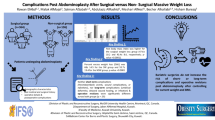Background
Morbid obesity is associated with various co-morbidities. With the significant weight loss, new dysfunctions arise, and prior body contour disorders start to severely affect the patient’s quality of life. The abdominal apron is generally the greater and the first disturbance faced by the post-bariatric patient.
Methods
The authors retrospectively reviewed their clinical experience in the treatment of those disorders through abdominoplasty. The benefits in terms of relief of said disorders and drawbacks in terms of surgical complications are described.
Results
117 abdominoplasties were performed from January 2002 to December 2005 on patients who had lost significant weight.The tissue removed ranged from 400 g to 10,500 g of adipose-cutaneous tissue (mean 2,276.5 g). Mean duration of the procedure was 4 hours and 25 minutes, with a maximum of 7 and a minimum of 2 and 40. Complication rate was 50.43%.
Conclusion
Abdominoplasty in the post-obese patient is an apparently simple procedure, which in fact causes a high rate of surgical complications. The complication rate is higher than that of cosmetic abdominoplasties. Nevertheless, the improvement in quality of life following such a procedure renders it a fundamental step in the rehabilitation of the formerly obese patient.
Similar content being viewed by others
References
Datta G, Cravero L, Margara A et al. The plastic surgeon in the treatment of obesity. Obes Surg 2006; 16: 5–11.
Strauch B, Herman C, Rohde C. Mid-body contouring in the post-bariatric surgery patient. Plast Reconstr Surg 2006; 117: 2200–11.
Da Costa LF, Landecker A, Manta M. Optimizing body contour in massive weight loss patients: the modified vertical abdominoplasty. Plast Reconstr Surg 2004; 114: 1917–23.
Aly AS, Cram AE, Heddens C. Truncal body contouring surgery in the massive weight loss patient. Clin Plast Surg 2004; 31: 611–24.
Rogliani M, Silvi E, Labardi L et al. Obese and nonobese patients. Complications of abdominoplasty. Ann Plast Surg 2006; 57: 336–8.
Matarasso A, Swift RS, Rankin M. Abdominoplasty and abdominal contour surgery: a national plastic surgery survey. Plast Reconstr Surg 2006; 117: 1797–808.
El-Khatib HA, Bener A. Abdominal dermolipectomy in an abdomen with pre-exisiting scars: a different concept. Plast Reconstr Surg 2004; 114: 992–7.
Al-Basti HB, El-Khatib HA, Taha A et al. Intraabdominal pressure after full abdominoplasty in obese multiparous patients. Plast Reconstr Surg 2004; 113: 2145–50.
Krueger JK, Rohrich RJ. Clearing the smoke. The scientific rationale for tobacco abstention with plastic surgery. Plast Reconstr Surg 2001; 108: 1063–73.
Manassa EH, Hertl CH, Olbrisch RR. Wound healing problems in smokers and nonsmokers after 132 abdominoplasties. Plast Reconstr Surg 2003; 111: 2082–7.
Savage RC. Abdominoplasty following gastrointestinal bypass surgery. Plast Reconstr Surg 1983; 71: 500–9.
Matarasso A, Wallach SG, Rankin M et al. Secondary abdominal contour surgery: a review of early and late reoperative surgery. Plast Reconstr Surg 2005; 115: 627–32.
Bragg TWH, Jose S, Srivastava S. Patient satisfaction following abdominoplasty: an NHS experience. Plast Reconstr Surg 2007; 60: 75–8.
Kelly HA. Excision of fat of the abdominal wall lipectomy. Surg Gynecol Obstet 1910; 10: 229.
Boriani F, Taveggia A, Cravero L. Obesity and body contouring: contemporary lessons from a historical example (Correspondence). Obes Surg 2005; 15: 1218.
Thorek M. Plastic reconstruction of the female breast and abdomen. Am J Surg 1939; 43: 268.
Pitanguy I. Abdominal lipectomy: an approach to it through an analysis of 300 consecutive cases. Plast Reconstr Surg 1967; 40: 384.
Callia WE. Uma plastica para cirurgiao geral. Med Hosp 1967; 11: 40.
Yach D, Stucker D, Brownell KD. Epidemiologic and economic consequences of the global epidemics of obesity and diabetes. Nat Med 2006; 12: 62–6.
Santry H, Gillen DL, Lauderdale DS. Trends in bariatric surgical procedures. JAMA 2005; 294: 1909–17.
Hensel JM, Lehman JA, Tantri MP et al. An outcomes analysis and satisfaction survey of 199 consecutive abdominoplasties. Ann Plast Surg 2001; 46: 357–63.
Sanger C, David LR. Impact of significant weight loss on outcome of body contouring surgery. Ann Plast Surg 2006; 56: 9–13.
Gravante G, Araco A, Araco F et al. Postobese patients and inherent surgical complications. Ann Plast Surg 2006; 56: 585–6.
Vastine VL, Morgan RF, Williams GS et al. Wound complications of abdominoplasty in obese patients. Ann Plast Surg 1999; 42: 34–9.
Deitel M. How much weight loss is sufficient to overcome major comorbidities? (Editorial) Obes Surg 2001; 11: 659.
Kroll SS, Netscher DT. Complications of TRAM flap breast reconstruction in obese patients. Plast Reconstr Surg 1989; 84: 886–92.
Nemerofsky RB, Oliak DA, Capella JF. Body lift: an account of 200 consecutive cases in the massive weight loss patient. Plast Reconstr Surg 2006; 117: 414–30.
Van Uchelen JH, Werker PM, Kon M. Complications of abdominoplasty in 86 patients. Plast Reconstr Surg 2001; 107: 1869–73.
Grazer FM, Goldwyn RM. Abdominoplasty assessed by survey with emphasis on complications. Plast Reconstr Surg 1977; 59: 513–7.
Kryger ZB, Fine NA, Mustoe TA. The outcome of abdominoplasty performed under conscious sedation: six-year experience in 153 consecutive cases. Plast Reconstr Surg 2004; 113; 1807–17.
Stewart KJ, Stewart DA, Coghlan B et al. Complications of 278 consecutive abdominoplasties. J Plast Reconstr Aesthet Surg 2006; 59: 1152–5.
Datta G, Boriani F, Obbialero FD et al. Body contouring after weight loss in morbid obesity: gain in health and leap in psychosocial functioning (Correspondence). Obes Surg 2006; 16: 673.
Author information
Authors and Affiliations
Corresponding author
Rights and permissions
About this article
Cite this article
Fraccalvieri, M., Datta, G., Bogetti, P. et al. Abdominoplasty after Weight Loss in Morbidly Obese Patients: A 4-Year Clinical Experience. OBES SURG 17, 1319–1324 (2007). https://doi.org/10.1007/s11695-007-9235-7
Received:
Accepted:
Published:
Issue Date:
DOI: https://doi.org/10.1007/s11695-007-9235-7




